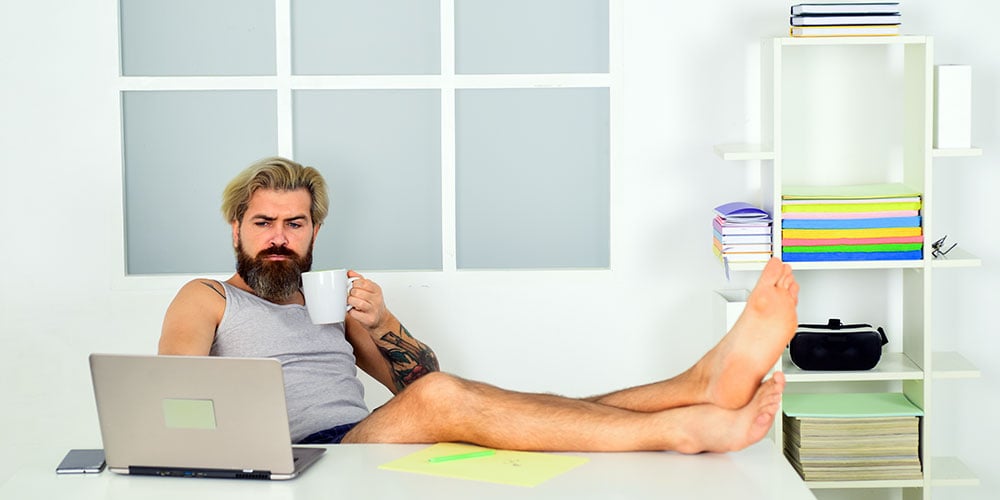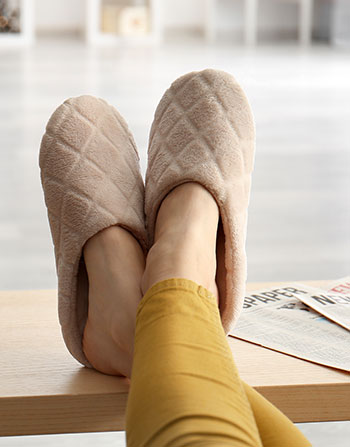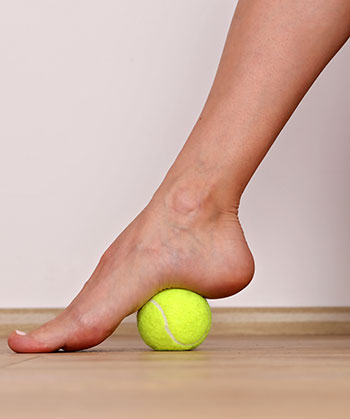
Wait a minute. You’re saying the days of the week have names? After a year plus of isolation and working from home, things can start to get a little fuzzy. Like those socks we wear all day. Unless we just go barefoot all day, every day.
Going barefoot is one of humanity’s throwback sensual freedoms. Walking with unfettered feet in the grass or on a sandy beach can be truly liberating. Just standing still and flexing your unbound toes can be exhilarating. Remember the giddy romance generated when Jane Fonda and Robert Redford went Barefoot in the Park?
However, despite the “barefoot running and minimalist shoe” craze of a few years ago, spending too much time walking or running shoeless on hard services, either indoors or out, increases your risk of injury and can be detrimental to your foot health.
Is “working from home foot” a real thing?
We’ve recently been diagnosing increasing instances of a relatively new syndrome: the WFH foot (working from home foot). This condition is primarily caused by spending long periods of time barefoot, or in those fuzzy socks. The result? Little or no arch support and excessive pronation.
Don’t misunderstand. We’re not trying to deprive you of some joyous shoe-free experiences on thick grass, dense carpet, or deep sand.
Are there any health benefits of walking barefoot?

Going barefoot on resilient, forgiving surfaces does produce some tangible benefits, such as improved circulation. And going shoeless gives some unaccustomed exercise to the intrinsic musculature of the foot.
Stronger feet contribute to improved posture, better balance, and enhanced proprioception (your body’s awareness of its relationship to its immediate surroundings). And barefoot fun itself is a worthy benefit.
How does going barefoot all day impair our feet?
Anything more than brief interludes of walking or running barefoot on hard surfaces can lead to a greater risk of impaired foot function.
Our feet come from the factory equipped with arches, and those arches vitally need support. Walking barefoot on hard surfaces can lead toward collapsed arches and flat feet.
The dangers of walking barefoot
There is another potential problem from prolonged barefooting. Our feet pronate (turn in) as they contact whatever surface we’re traversing. Walking barefoot increases both the degree of pronation and its duration. This affects the biomechanical distribution of pressures throughout the foot.
These alterations may in turn accelerate the progression of latent foot deformities, such as bunions, hammertoes, and Achilles tendonitis. Constantly going barefoot, even indoors, can lead to heel pain, plantar fasciitis, and metatarsalgia (generalized pain in the forefoot).
And the harm may not be confined to your feet. The imbalances generated by excessive pronation can transfer upward to other parts of the body, causing poor posture, knee problems, and even spinal difficulties.
Some practical reasons to avoid excessive indoor shoelessness
When you are wearing protective footwear, your toes won’t be location devices for chair legs and bedposts. Stubbed toes cause pain and bad words. And when you drop that slippery bottle of mayonnaise, it would be nice to have something protecting your foot. (It’s best not to think about the consequences of stepping barefoot on sharp objects, like a half-finished Lego project).
You don’t have to be shod like a logger to avoid foot injuries from excessive indoor barefooting. Your regular shoes, with sufficient arch support and ample cushioning, will provide the most protection. But slippers, and even sandals like these arch support flip-flops, can suffice, so long as they have relatively deep heel cups and the arch support is substantial.
4 foot exercises for foot pain relief
You can enjoy being barefoot while regularly performing exercises and stretches to keep your feet healthy. Here are four of our favorites for your footcare:
1. Toe raise, point, and curl
Sit in a chair with your feet flat on the floor.
While keeping your toes on the floor, raise your heels. Stop when only the balls of your feet are touching the ground. Hold that position for five seconds.
Next, raise your heels and point your toes, so that only the tips of your longest toes are resting on the floor. Hold this position for five seconds.
Finally, raise your heels and curl your toes inward, so that only the tips of your toes are touching the floor. Hold this position for five seconds as well.
Repeat each stage 10 times.

2. Toe splay
Sit in a chair with your feet resting on the floor.
Spread your toes as far apart as you can without causing pain. Hold this position for five seconds.
Repeat this motion 10 times.
3. Marble pickup
Sit in a chair with your feet flat on the floor.
Put two bowls on the floor in front of you. In one bowl put 20 marbles. Leave the other ball empty.
Use your toes to pick up each marble and place it in the other bowl. Do this with each foot.
4. Ball roll
Place a golf ball on the floor.
Put the sole of your foot on the ball and roll it around, pressing down as hard as is comfortable.
Let the ball massage the bottom of your foot. Continue for as long as you want, then repeat on the other foot
A tennis ball can be substituted. For more pain relief, you can also use a frozen bottle of water.
Why choose University Foot and Ankle Institute for your foot and ankle care?
If you’re experiencing foot problems, we’re here to help. Our podiatrists offer the most advanced podiatry care and the highest success rates in the nation. We are nationally recognized foot and ankle specialists and leaders in researching, diagnosing, and treating all foot and ankle conditions.
At University Foot and Ankle Institute, we take our patients’ safety seriously. Our facility’s Covid-19 patient safety procedures exceed all CDC recommendations.
For more information or to schedule a consultation in the greater Los Angeles area, please call (877) 736-6001 or make an appointment now.
University Foot and Ankle Institute is conveniently located throughout Southern California and the Los Angeles area as our foot doctors are available at locations in or near Santa Monica, Beverly Hills, West Los Angeles, Manhattan Beach, Northridge, Downtown Los Angeles, Westlake Village, Granada Hills, and Valencia, California.
- State-of-the-Art CT Scanning, Now in Our Office - September 21, 2023
- How to Break in New Running Shoes According to a Podiatrist - January 11, 2022
- 7 Foot and Ankle Strengthening Exercises - October 13, 2021
Leave a Reply